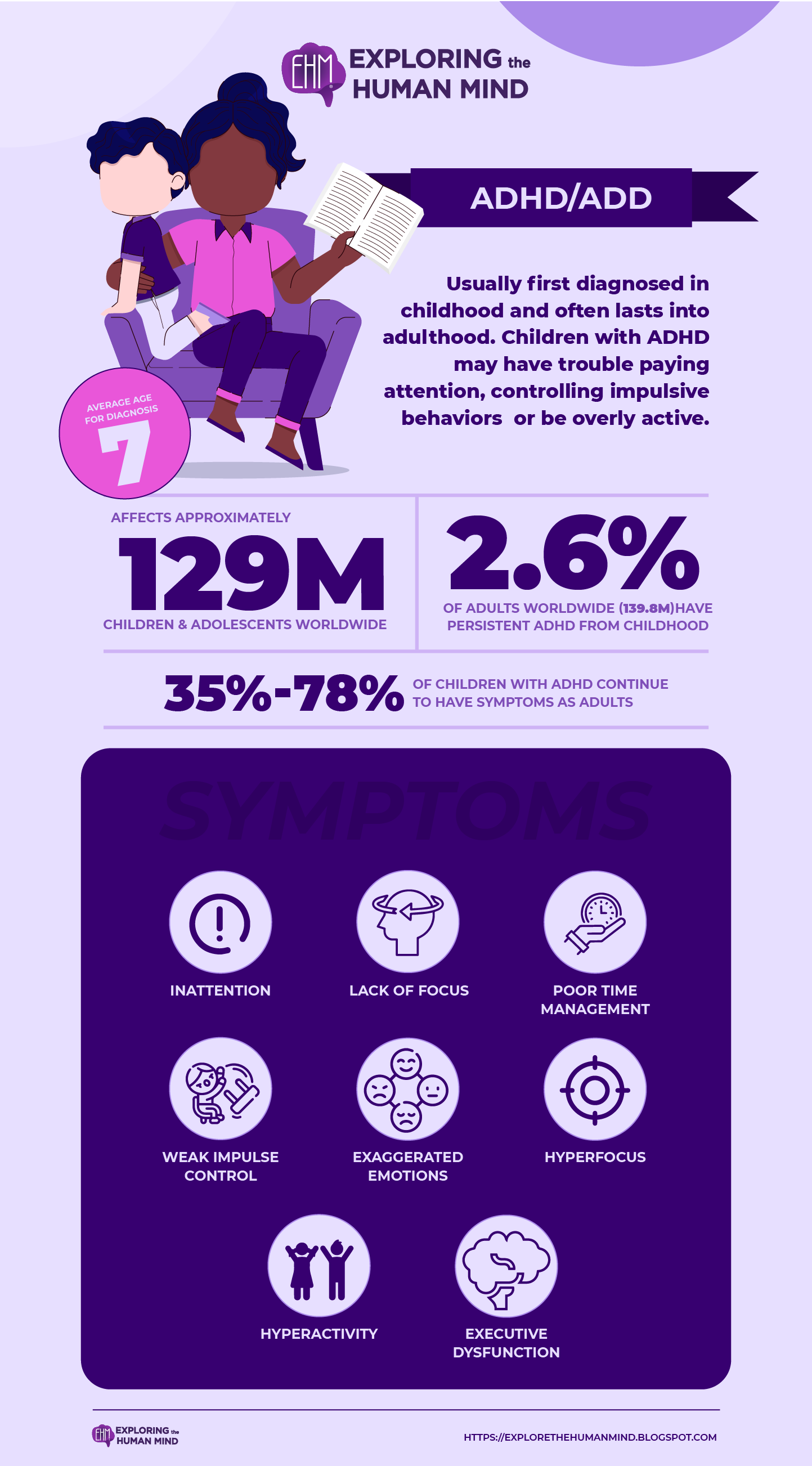ADHD/ADD
ADD was the name until 1987 when the word "hyperactivity" was added. Previously, a child would be diagnosed with ADD, either with or without hyperactivity, say in 1980. That child, however, would be diagnosed with ADHD beginning in the early 1990s.
Diagnoses included one of three types from the early 1990s until recently. Inattentive type refers to children who only have inattentive symptoms. Children who were only hyperactive and impulsive were classified as hyperactive/impulsive. Children who had all three symptoms were identified as having the combined type.
ADHD is one of the most common neurodevelopmental disorders of childhood. It is usually first diagnosed in childhood and often lasts into adulthood. Children with ADHD may have trouble paying attention, controlling impulsive behaviors (may act without thinking about what the result will be), or be overly active.
Symptoms:
- Inattention
- Lack of focus
- Poor time management
- Weak impulse control
- Exaggerated emotions
- Hyperfocus
- Hyperactivity
- Executive dysfunction
Causes
The causes of ADHD are still unknown. According to research, genetics and heredity play a significant role in determining who gets ADHD. Scientists are still investigating whether certain genes, particularly those linked to the neurotransmitter dopamine, play a specific role in the development of ADHD.
According to additional research, certain chemicals may increase a child's risk of ADHD.
ADHD is not caused by poor parenting, excessive sugar consumption, or excessive video game play. ADHD is a biological brain disorder. Many physiological differences in the brains of people with ADHD have been discovered through brain imaging studies and other research.

vectors by Freepick; graphic design by Vadot
Although many children exhibit ADHD-like behaviours, they do not necessarily have the disorder. An ADHD diagnosis requires that these behaviours have been present for at least 6 months, that some symptoms began before the age of 12, that symptoms exist in two or more settings (such as school and home), and that they have a significant impact on the child in at least two areas (social life, school, etc.).
Statistics
- ADHD affects approximately 129 million children and adolescents worldwide between the ages of 5 and 19.
- By 2020, more than 366 million adults worldwide will have ADHD.
- The average age for ADHD diagnosis is seven.
- Approximately 2.6% (139.8 million) of adults worldwide have persistent ADHD from childhood, which includes individuals who had ADHD symptoms as a child and continued to have them as adults.
- Approximately 6.8% (366.3 million) of adults worldwide have symptomatic ADHD, which includes people diagnosed with ADHD at any age.
- The prevalence of symptomatic adult ADHD decreases with age; 18- to 24-year-olds account for more than 75.5 million cases, while individuals over 60 account for approximately 46.4 million cases.
- An estimated 35% to 78% of children with ADHD continue to have symptoms as adults.
- High school graduates with ADHD earn 17% less per year than those without ADHD.
- ADHD in childhood is linked to an increased risk of death before the age of 46.
Reference:
What is ADHD?. (2021, January 26). Centers for Disease Control and Prevention. https://www.cdc.gov/ncbddd/adhd/facts.html#:~:text=ADHD%20is%20one%20of%20the,)%2C%20or%20be%20overly%20active.
NHS Choices. (2023). Overview - Attention deficit hyperactivity disorder (ADHD). https://www.nhs.uk/conditions/attention-deficit-hyperactivity-disorder-adhd/
What is the difference between ADD and ADHD? - Child Mind Institute. (2023, March 3). Child Mind Institute. https://childmind.org/article/what-is-the-difference-between-add-and-adhd/
What Is ADHD? Attention Deficit Hyperactivity Disorder in Children and Adults. (2017, March 15). ADDitude. https://www.additudemag.com/what-is-adhd-symptoms-causes-treatments/
ADHD Statistics. (2023, June 13). Forbes. https://www.forbes.com/health/mind/adhd-statistics/#:~:text=Approximately%20129%20million%20children%20and,have%20ADHD%20as%20of%202020.






Comments
Post a Comment